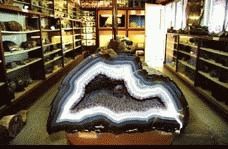IN SEARCH OF THUNDEREGGS RANCH IS PLENTIFUL SOURCE OF AGATE NODULES
Published 12:00 am Friday, August 26, 2005

- A KEEPER: A bulky amethyst geode sits at the entry of one of the showrooms at Richardson's Recreation Ranch. (The (Bend) Bulletin/DEAN GUERNSEY).
Jim Witty
WesCom News Service
MADRAS Richardson’s Recreational Ranch is 17,000 acres of juniper canyons, flat-top bluffs, bone-dry streambeds and hard-scrabble, with cross-bred cows grazing out over the flats.
The ranch, situated 11 miles north of Madras on Highway 97, is also one of the most productive spots in the world to find thundereggs, those agate nodules highly prized by rockhounds and collectors.
Cut and buffed, the orbs with their dreamlike three-dimensional innards make exquisite paper weights look, it’s the Okefenokee Swamp; no, it’s Aunt Harriet’s Shih Tzu.
But it’s hunting them up and digging them out that gets in your blood. And it’s visiting with Johnnie and Norma Richardson, browsing through their well-appointed rock shop and cruising around their ranch like Indiana Jones and family on a Sunday drive that makes for a full-fledged adventure.
We walked into rockhound central and were greeted warmly by Johnnie and Norma, seated at far ends of the counter. A couple of baby chicks bobbed and weaved around Bonnie’s feet andamp;quot;They think I’m their mother,andamp;quot; she says as she launched into the rules of the game. Grab a bucket and a couple of picks, she said, gruff but smiling. The picks are $30 apiece if you leave them out on the diggings. I don’t care if you are writing a story. Follow this road, then that. Got water? It’s hot.
And then we were bouncing up a dirt road, bound for the interior of the ranch and the world-famous Priday thunderegg beds seven miles beyond.
Not far past the ranch headquarters, my wife volunteered to drive. The uncharacteristic offer had me scratching my head until we came to the first gate and I had to bail out and tend to the latches. Four gates in all for the round trip. That’s cowgirl logic.
According to Johnnie Richardson, the Priday beds have been tapped since 1928 and show little sign of petering out. In 1976, he and his family bought 2,000 acres, which included the Priday thunderegg diggings, and added them to the Richardson holdings. It’s a rich lode.
From the parking area just above the Blue Bed, we glimpsed snow-capped Mount Hood shimmering beyond the heat waves and a liberal sprinkling of intact thundereggs under a nearby juniper. So this is what we were after.
A short downhill walk and we were facing a rocky ledge, about four feet high and 50 or 60 yards long. Another party had arrived first; my initial pang of disappointment evaporated when I discovered we were literally rolling in discarded thundereggs when we
didn’t watch our step.
We found an open section and started hacking at the rock. Soon, we had homed in on the prize: bulbous thundereggs raised in relief from the cross section of stone. Whack, chisel, chip. Whack, chisel, chip. Rats. An errant whack cracked my first egg before I could unearth it. But we got better at it and bucketed several nice specimens before the heat and the promise of an ice-cold drink drew us back over those rutted roads.
The Richardsons charge 75 cents a pound for the eggs you harvest. That includes cutting them in half, but the polishing part is up to you.
Thundereggs generally run from golf-ball to soft-ball size, with about one in 20 becoming outstanding cut-and-polished specimens, according to the Richardsons.
Other than size, thundereggs look alike on the outside nondescript and sandy brown. But each specimen is different on the inside, according to the company brochure. They were formed in layers of rhyolite lava flows, an estimated 60,000 years ago. Geologists postulate that thundereggs formed in gas pockets, which acted as molds. Over a long stretch, the gas cavities were filled with silica-rich water, leaving a dark matrix material and the crystalized inner core of agate or chalcedony.
In addition to the generous supply of dig-your-own thundereggs, Richardson’s Recreational Ranch offers a store full of finished cut and polished thundereggs and other rocks from all over the world.
Johnnie Richardson estimates that more than 65 percent of rock shops around the world carry thundereggs from the family ranch.
In addition to rockhounding, Richardson’s Recreational Ranch offers stellar opportunities for photography and camping.





